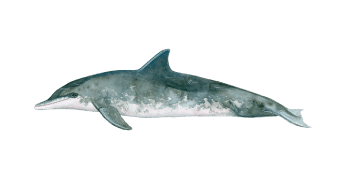
Rough-toothed dolphin
(Steno bredanensis)
Little is known about the smart, deep-diving dolphins whose conical head and large eyes give them a somewhat reptilian appearance. Their name is derived from the characteristic longitudinal ridges on the surface of their teeth.
This species is gregarious and lives in groups of 10 to 50 individuals. The species can sometimes seen in the company of Bottlenose dolphins and Spotted dolphins.
They often have scars and paler areas on their side many of which may be due to cookie-cutter shark bites. Very intelligent animals that have often been observed playing with debris at the oceans surface and have even been documented to present fish that they had just caught before eating them.
General information
Further names: Portuguese: Caldeirão; English: Slopehead, Steno
Size of adults: 2.1 – 2.6 m
Prey: Fish and cephalopods.
Behaviour: Despite them not being active at the surface, they are extremely powerful swimmers, often seen diving and resurfacing repeatedly in a synchronised manner in groups of two or more.
Range: Warm to tropical oceans, tend to prefer deeper water.
Madeira: Often encountered during the summer in small compact groups often containing calves.
Distinctive features: Relatively large teeth with fine longitudinal ridges align their jaws, covered by white to rosy lips. Their conical head with its relatively large eyes slopes smoothly into a slender beak with no demarcation. The back and the sides are dark grey with pale to rosy markings on the sides, their belly is white to rosy. They have a high, sickle-shaped dorsal fin that resembles that of Bottlenose dolphins at a distance. They have large flippers and flukes for their size.
Taxonomy: Suborder: Odontoceti (Toothed whales), Family: Delphinidae (Dolphins)
Threats: No reliable data on population size but estimates put the number of animals world-wide at around 150,000. This species is also under increasing pressure through fishing activity, noise pollution and the chemical pollution of the oceans.
